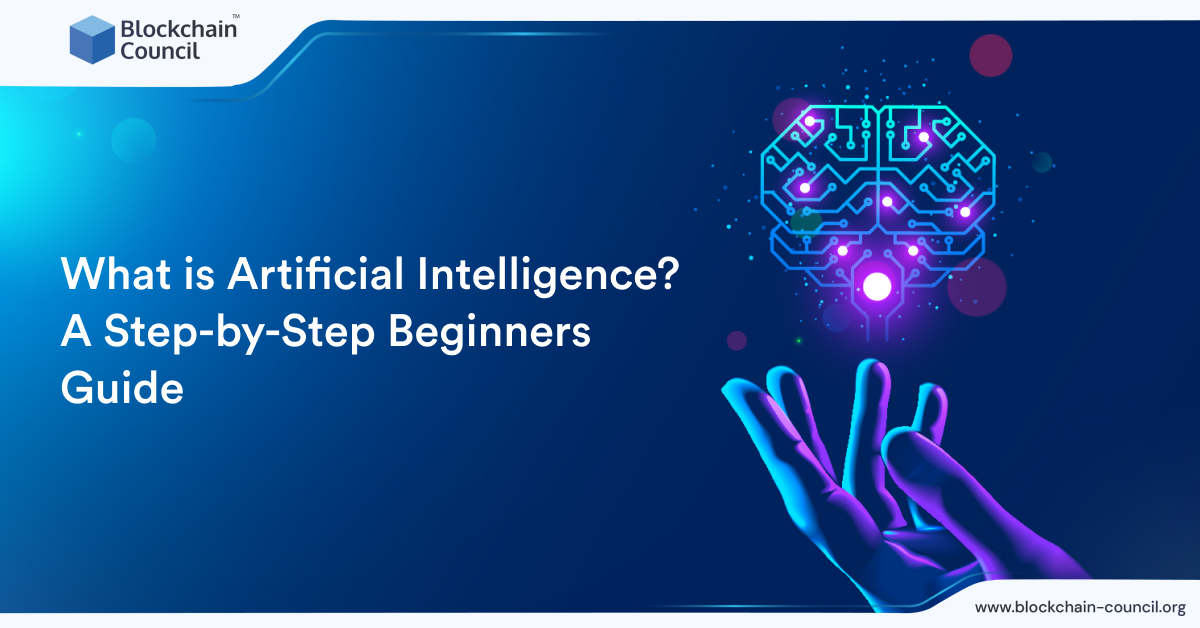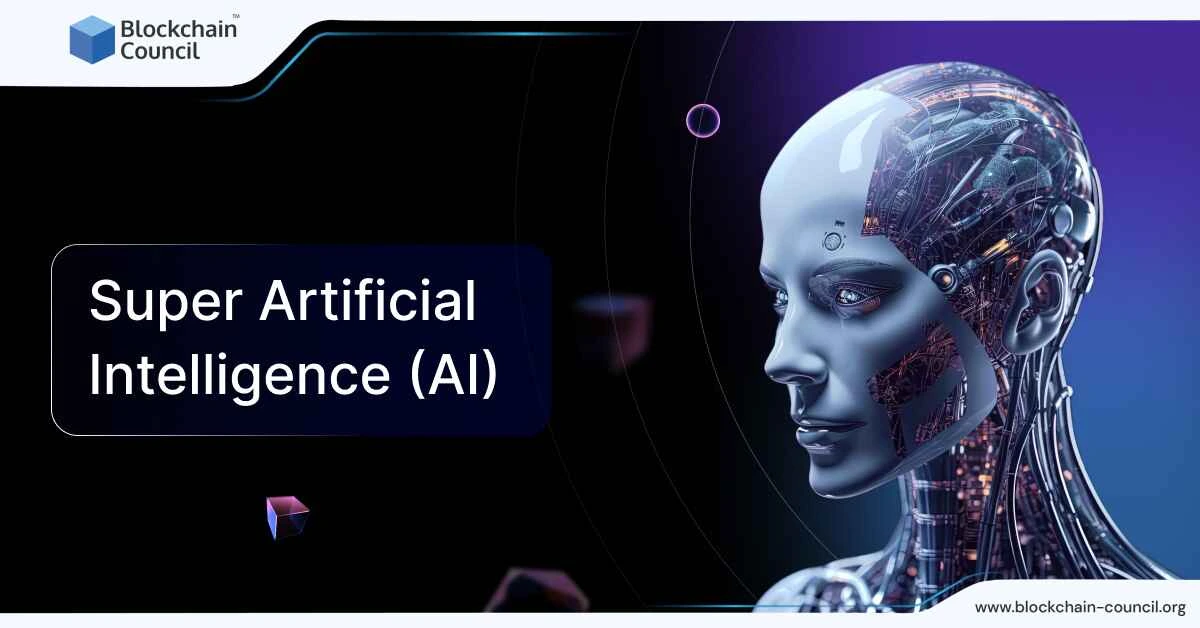
- Blockchain Council
- September 17, 2024
Summary
- Artificial intelligence (AI) has been making waves across various industries in recent years.
- The history of artificial intelligence (AI) dates back to the 1950s.
- The first phase of AI research was marked by the development of “expert systems”.
- Artificial Intelligence (AI) can be broadly classified into two categories.
- Narrow AI is designed to perform specific tasks.
- AI systems are increasingly used in criminal justice to make decisions.
- The future of AI is exciting, and the technology is expected to play an increasingly.
Introduction
Artificial intelligence is an innovative and transformative technology that has been making waves across various industries in recent years. It refers to developing computer systems that are capable of performing tasks that typically require the indulgence of human intelligence, such as decision-making, visual perception, and speech recognition. As AI evolves and becomes more sophisticated, its impact on society will only grow.
Understanding AI can be daunting for beginners, but gaining a basic understanding of this technology is essential, given its increasing importance in our daily lives. This article will explore what AI is, its growing importance, and why it’s crucial to have a foundational understanding of this transformative technology. For those who are interested in taking it up as a career, we will also discuss different AI certifications that can help you achieve your goal with ease.
Basics and Brief History of Artificial Intelligence
Artificial intelligence (AI) came into existence in the 1950s when the term “artificial intelligence” was first coined. Creating machines that can perform tasks that normally require human intelligence has fascinated scientists and researchers for centuries. The development of AI can be divided into several phases, each marked by significant advancements in technology and new ideas.
First Phase
The first phase of AI research was marked by the development of “ES” (expert systems) in the 1960s. These computer programs use a set of rules to make decisions and solve problems in specific domains, such as medical diagnosis or financial analysis. However, these systems had limited capabilities and could not learn from new data.
Second Phase
The second phase of AI research, which started in the 1980s, focused on machine learning. Researchers developed algorithms to learn from data and improve their performance over time. One of the most important developments during this period was the introduction of neural networks, which were inspired by the structure and function of the human brain.
Third Phase
The third phase of AI research, which started in the 1990s, was characterized by the development of more sophisticated machine learning techniques, such as support vector machines and decision trees. During this period, AI was used in real-world applications, such as speech recognition, computer vision, and natural language processing.
Fourth Phase
The fourth phase of AI research, which started in the 2010s, is marked by the rise of deep learning, which uses neural networks with many layers to learn complex data representations. Deep learning has led to significant advances in image and speech recognition, natural language processing, and robotics.
Present Scenario
Today, AI is used in many applications, from self-driving cars and personalized healthcare to virtual assistants and smart homes. While early AI systems were limited in capabilities, machine learning and deep learning development have led to significant progress in recent years. We have discussed different types of artificial intelligence and how they are being used today in various industries and daily life.
Also Read- How to Specialize in Blockchain: A Comprehensive Guide
Types of Artificial Intelligence
Artificial Intelligence (AI) can be widely classified into two major categories. Let’s try to understand them with real-life examples and use cases.
Narrow AI
Also known as weak AI, narrow AI is designed to carry out specific instructions-based tasks. These systems are trained to recognize patterns and make decisions based on the data provided to them.
Some common examples of narrow AI in everyday life include:
- Virtual assistants such as Siri and Alexa respond to voice commands and perform tasks like setting reminders, making calls, or playing music
- Image recognition software used in social media apps like Facebook and Instagram automatically tags people in photos
- Email providers use spam filters to filter out unwanted messages automatically
- Navigation systems like Google Maps provide real-time traffic updates and route suggestions
General AI
Also known as strong AI, general AI is designed to perform any intellectual task that a human can do. These systems are capable of learning from experience and adapting to new situations.
While general AI is still largely a theoretical concept, some potential examples of general AI in everyday life include:
- Personalized medical diagnosis and treatment recommendations based on a patient’s medical history and genetic profile.
- Automated customer service chatbots that can understand and respond to complex inquiries.
- Intelligent personal shopping assistants can recommend products based on a person’s preferences, budget, and style.
- Autonomous vehicles that can safely navigate complex environments and make real-time decisions based on changing road conditions.
Apart from narrow and general AI, several other types are used in different applications. Some of these types include:
Supervised Learning
Supervised learning is a type of machine learning where an algorithm is trained on a labeled dataset. The algorithm learns to map inputs to outputs based on the examples provided to it. For instance, a supervised learning algorithm can be trained on a dataset of images labeled as cats or dogs to recognize new images as either cats or dogs.
Use-cases
- Spam filters are used in email providers that can identify and filter out spam messages from legitimate ones based on labeled data.
- Credit scoring models are used by banks that analyze customer data to predict the likelihood of loan repayment.
Unsupervised Learning
In unsupervised learning, an algorithm is trained on an unlabeled dataset. The algorithm learns to recognize data patterns and structures without predefined labels. For example, an unsupervised learning algorithm can cluster similar customer groups based on their purchasing behavior.
Use Cases and Examples
- Clustering customer data to identify patterns and preferences to personalize marketing campaigns.
- Anomaly detection algorithms are used to identify fraudulent transactions in financial systems.
Reinforcement Learning
Reinforcement learning is a type of machine learning that focuses on training an algorithm to make decisions based on the feedback it receives from its environment. The algorithm learns to take actions that maximize a reward function over time. For instance, a reinforcement learning algorithm can teach a robot to navigate a maze.
Use Cases and Examples
- Self-driving cars learn to navigate the road and respond to obstacles in real-time based on the rewards and penalties assigned to their actions.
- Game-playing AI agents that learn to optimize their strategies in response to the opponent’s moves.
Deep Learning
Deep learning is a type of machine learning that uses deep neural networks with multiple layers to learn and classify data. Deep learning has been used in various applications, such as speech recognition, image recognition, and NLP (natural language processing).
Use Cases and Examples
- Image recognition systems are used in social media apps to tag people in photos automatically.
- Speech recognition software is used by virtual assistants to understand spoken commands.
Transfer Learning
Transfer learning is a machine learning technique that reuses pre-trained models on new tasks. Transfer learning can save the time and resources required to train models from scratch. For instance, a pre-trained image recognition model can be fine-tuned to recognize specific objects in a new dataset.
Use Cases and Examples
- Image classification models are pre-trained on large datasets like ImageNet and then fine-tuned for specific tasks like identifying skin cancer in medical imaging.
- Natural language processing models are pre-trained on large text corpora like Wikipedia and then fine-tuned for specific tasks like sentiment analysis in social media.
Cognitive Computing
Cognitive computing is an AI that aims to mimic human cognition and reasoning abilities. Cognitive computing systems can understand natural language, recognize emotions, and perform complex tasks. Some examples of cognitive computing include IBM Watson and Google Duplex.
Use Cases and Examples
- Personalized healthcare systems that can analyze patient data to provide personalized treatment recommendations.
- Intelligent personal shopping assistants can recommend products based on a person’s preferences, budget, and style.
Also Read- How to Become a Blockchain Architect?
What is Machine Learning?
Machine learning (ML) is a subfield of artificial intelligence (AI) that focuses on developing algorithms and statistical models that allow computer systems to automatically improve their performance on a task without being explicitly programmed. In other words, machine learning enables machines to learn from data and make predictions or decisions based on that data.
There are three major machine learning types: supervised learning, unsupervised learning, and reinforcement learning. We have provided a detailed discussion about them in detail in the previous section.
Machine learning has many real-life applications in a variety of fields. One common application is recommendation systems, which use machine learning algorithms to suggest products, movies, or other items based on a user’s past behavior or preferences. Another example is fraud detection, where machine learning algorithms can analyze financial transactions to detect fraudulent activity. Other machine-learning applications include image and speech recognition, natural language processing, autonomous vehicles, and predictive maintenance in industrial settings.
Also Read- Road to VR | How to Set Up your Room for VR
What is Natural Language Processing (NLP)
NLP pertains to Natural Language Processing, a subfield of AI that deals with bi-channel interaction between human languages and computers. In simple terms, NLP focuses on how machines can interpret, understand, and manipulate human language in a way that is useful for humans.
NLP involves various techniques and technologies, including computational linguistics, machine learning, and deep learning. NLP aims to enable machines to understand and generate human language and perform tasks such as language translation, sentiment analysis, and text classification.
Applications of NLP
Some of the key industrial applications of natural language processing are:
Language Translation
NLP can be used to translate text from one language to another which is currently done through multilingual site providing translation and more. Machine translation systems use statistical models and neural networks to translate text with varying degrees of accuracy.
Sentiment analysis
NLP can analyze the sentiment or emotion expressed in text, such as customer reviews or social media posts. Sentiment analysis algorithms can classify text as positive, negative, or neutral and identify specific emotions such as anger or joy.
Text classification
NLP can classify given text into multiple categories, such as non-spam or spam emails or news articles by topic.
Chatbots and virtual assistants
NLP is often used in chatbots and virtual assistants, which can understand natural language queries and respond with relevant information or actions.
Speech recognition
NLP can convert spoken language into text, which can then be analyzed or translated.
Also Read- How to Become a Smart Contract Developer?
Techniques Used in Natural Language Processing
Natural Language Processing (NLP) is a rapidly evolving field of study involving various techniques to enable machines to understand, interpret, and manipulate human language.
Here are some of the key techniques used in NLP:
Tokenization
Tokenization is breaking down the text into individual words or tokens. This is a crucial first step in many NLP tasks, allowing the machine to analyze and manipulate individual words or phrases.
Part-of-speech tagging
Part-of-speech (POS) tagging assigns a part of speech to each word in a text, such as a noun, verb, or adjective. POS tagging is important for tasks such as text classification and sentiment analysis, as it provides information about the grammatical structure of a sentence.
Named entity recognition
Named entity recognition (NER) identifies and classifies named text entities, like places, people, & organizations. NER is important for tasks such as information extraction and question answering.
Parsing
Parsing is the process of analyzing the typical grammatical structure of a sentence. This involves identifying the relationships between words and phrases, such as subject-verb-object relationships.
Sentiment analysis
Sentiment analysis is analyzing the emotion or sentiment expressed in text. This can involve identifying positive, negative, or neutral sentiments and specific emotions such as anger or joy.
Language modeling
Language modeling involves building statistical models of language, which can be used to predict the probability of a sequence of words. Language models are important for tasks such as speech recognition and machine translation.
Topic modeling
Topic modeling is identifying topics or themes in a collection of texts. This can be done using techniques such as LSA (latent semantic analysis) and LDA (latent Dirichlet allocation).
Machine translation
Machine translation involves the automatic translation of text from one language to another. This is typically done using statistical or neural machine translation models.
What are AI Ethics and Bias?
AI ethics refers to the moral and ethical considerations surrounding the development and use of artificial intelligence (AI) systems. It ensures that AI systems are developed and used responsibly and ethically, benefiting individuals and society.
AI bias refers to how AI systems can reflect and reinforce biases in the data and algorithms used to develop them. Bias can occur in many different ways, such as collecting and using partial data, biased algorithms, or incorporating biased assumptions and values into the design of AI systems.
Why are AI ethics and biases important?
AI ethics and bias are important for several reasons. Here are some of the key reasons:
Fairness and equity
AI systems can significantly impact people’s lives, such as in employment, education, and criminal justice. It is important that these systems are fair and unbiased and do not perpetuate or reinforce existing biases and inequalities.
Safety and Security
AI systems can also have implications for safety and security, such as in autonomous vehicles and cybersecurity. It is important that these systems are reliable and secure and do not pose unnecessary risks to individuals or society as a whole.
Trust and transparency
AI systems can be complex and difficult to understand, making it challenging for people to trust them. These systems must be transparent and explainable so that people can understand how they work and why they are making certain decisions.
Accountability and responsibility
AI systems can take action and make decisions that can lead to some horrible real-world consequences. It is important that there is accountability and responsibility for these decisions and actions and that those responsible are held to appropriate ethical and legal standards.
Legal and regulatory compliance
AI systems are subject to various legal and regulatory frameworks, including privacy, data protection, and anti-discrimination laws. These systems must be designed and used in compliance with these frameworks.
To address these issues, it is important to have a framework for AI ethics and bias that includes principles such as fairness, accountability, transparency, and privacy. It is also important to have tools and techniques for detecting and mitigating bias in AI systems, such as data cleaning and preprocessing algorithmic fairness metrics and interpretability techniques. By addressing AI ethics and bias, we can ensure that AI systems are developed and used responsibly and ethically, that benefits individuals and society as a whole.
Examples of AI bias and its implications
Hiring bias
AI systems can be used to automate the initial hiring process where you screen different job candidates. However, if the data used to train these systems is biased, the systems can perpetuate or even amplify existing biases. For example, if historical hiring data shows a bias towards certain demographic groups, an AI system trained on this data may also show a bias towards these groups. This can lead to discriminatory hiring practices and the exclusion of qualified candidates.
Criminal justice bias
AI systems are now getting trained to be used in criminal justice to make decisions such as bail and sentencing. However, if the data used to train these systems is biased, the systems can perpetuate or even amplify existing biases. For example, if historical data shows a bias toward certain demographic groups, an AI system trained on this data may also show a bias toward these groups. This can lead to unfair and discriminatory outcomes in the criminal justice system.
Healthcare bias
AI systems are being developed to assist in treatment decisions and medical diagnosis. However, if the data used to train these systems is biased, the systems can perpetuate or even amplify existing biases. For example, if historical medical data shows a bias toward certain demographic groups, an AI system trained on this data may also be biased toward these groups. This can lead to delayed and incorrect diagnoses and inappropriate treatments for certain groups.
Financial bias
AI systems are used in finance for credit scoring and loan approval decisions. However, if the data used to train these systems is biased, the systems can perpetuate or even amplify existing biases. For example, if historical financial data shows a bias towards certain demographic groups, an AI system trained on this data may also show a bias towards these groups. This can lead to discriminatory lending practices and limited & controlled access to financial services for specific groups.
The Future of Artificial Intelligence
Artificial intelligence has the indefinite potential to impact society in various ways significantly. AI-powered systems can improve productivity and efficiency with enhanced decision-making processes, bringing new levels of convenience to our daily lives. However, with these opportunities come significant challenges as well.
One of the major opportunities for AI lies in healthcare, where AI-powered systems can assist in medical diagnosis, personalized treatments, and drug development. In addition, AI can also contribute in the form of autonomous vehicles, making traveling and transportation much safer and more efficient.
However, the rise of AI also presents significant challenges. One of the most pressing challenges is the potential job loss due to automation. AI also raises concerns about privacy, security, and the ethical use of data. There is a need to make sure that Artificial Intelligence is developed ethically and responsibly to avoid unintended consequences.
Why Should You Become an AI Developer?
There are numerous reasons why you should choose AI development or AI engineering as a career. Firstly, the demand for AI developers is rising as more businesses adopt AI-powered solutions to stay competitive. As an AI developer, you will be at the forefront of cutting-edge technologies, constantly learning and improving your skills. Many AI developers work remotely, and there are freelance opportunities as well. As an AI developer, you have the opportunity to work with top global companies that are leading the way in AI development. These companies offer exciting and challenging projects and the chance to develop innovative, cutting-edge technologies.
In addition, AI engineering is in high demand in the tech industry and various sectors such as healthcare, finance, and manufacturing. This means that you have a wide range of job opportunities as an AI developer.
How to become an AI developer?
To become an AI developer, you must have a strong computer science, programming, and mathematics foundation. Becoming an AI developer requires dedication and hard work, but the rewards are worth it. You can work on projects that make a real difference and be part of a global community of developers shaping technology’s future. Here is an overview of your required skills to become a skilled AI developer.
-
Programming languages
Proficiency in popular and crucial programming languages such as Python, Java, C++, and R is essential for AI development.
-
Data structures and algorithms
Understanding the basics and advanced concepts of DSA is crucial for developing efficient AI applications.
-
Machine learning
Knowledge of machine learning algorithms such as unsupervised, supervised and reinforcement machine learning is essential for AI development.
-
Deep learning
Expertise in deep learning frameworks such as TensorFlow, PyTorch, and Keras is essential for developing complex AI applications.
-
Natural Language Processing (NLP)
NLP is a key area of AI development, and knowledge of NLP techniques and libraries is important for building AI-powered chatbots, virtual assistants, and other language-based applications.
-
Computer Vision
Understanding computer vision libraries like OpenCV, sci-kit-image, and machine learning techniques to develop computer vision applications.
-
Big Data technologies
Knowledge of big data technologies like Hadoop, Spark, and NoSQL databases is important for handling large datasets in AI development.
AI development requires a strong foundation in programming languages, machine learning, deep learning, NLP, computer vision, and big data technologies. With these skills, you can build AI applications that solve complex problems and significantly impact society.
Conclusion
This article discusses the fundamentals of artificial intelligence (AI) and its increasing importance in society. We explored the various applications of AI in different industries and its impact on our daily lives. AI is a transformative technology that has the potential to solve complex problems, improve efficiency, and enhance our quality of life. However, with great power comes great responsibility, and we must be mindful of the ethical implications and biases that can arise from AI development.
As the demand for skilled AI developers rises, we encourage readers to continue learning and exploring AI development. With dedication and hard work, anyone can become an AI developer and contribute to this exciting and rapidly evolving industry. As we continue to embrace the potential of AI, we must also remain vigilant and ensure that we are using this technology to better society as a whole. If you plan to start your career in this emerging technology, we suggest you check out Blockchain Council Certifications for Artificial Intelligence (AI) Expert and developer roles.
FREQUENTLY ASKED QUESTIONS
What is Artificial Intelligence?
Artificial Intelligence (AI) refers to the simulation of human intelligence in machines that are programmed to think and act like humans. It involves the development of algorithms that can process and analyze vast amounts of data, recognize patterns, and learn from experience to make predictions or decisions.
- High energy consumption and scalability issues
- Regulatory and legal challenges
- Security risks such as 51% attacks and smart contract vulnerabilities
- Lack of standardization and interoperability between different Blockchains
- Limited public awareness and adoption in some industries and regions.
What are the benefits of AI?
AI has the potential to revolutionize various industries and fields, including healthcare, finance, transportation, and education. Some of the benefits of AI include increased efficiency and productivity, improved decision-making, better customer experience, and enhanced accuracy and precision.
What are the ethical concerns surrounding AI?
The development of AI has raised several ethical concerns, including issues related to privacy, security, bias, transparency, and accountability. For instance, there is a concern that AI could be used to perpetuate existing social and economic inequalities or be used for malicious purposes.
How is AI being used in the real world?
AI is being used in a variety of real-world applications, including image and speech recognition, autonomous vehicles, predictive analytics, fraud detection, and virtual assistants. AI is also being used in healthcare to develop personalized treatment plans and to analyze medical images.
What is the future of AI?
The future of AI is exciting, and technology is expected to play an increasingly important role in our lives. AI is likely to continue to evolve and become more sophisticated, leading to new applications and advancements in fields such as medicine, transportation, and robotics. However, the potential risks associated with AI must also be addressed, such as the displacement of jobs and the need to ensure that AI is used ethically and responsibly.





































































 Guides
Guides News
News Blockchain
Blockchain Cryptocurrency
& Digital Assets
Cryptocurrency
& Digital Assets Web3
Web3 Metaverse & NFTs
Metaverse & NFTs
